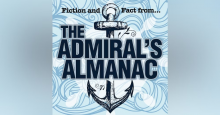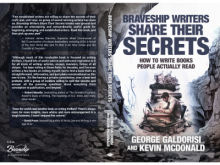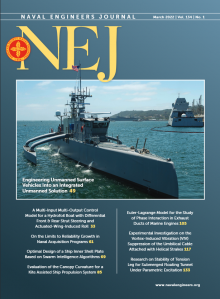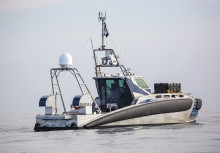Publisher avatar for Naval Helicopter Association, Inc
from Rotor Review Spring 2023 #160
by Naval Helicopter Association, Inc
One of the great things about working at a Navy Warfare Center, such as Naval Information Warfare Center Pacific, is that you have the opportunity to see new technologies envisioned, created, and, in many cases, implemented into the Fleet or Fleet Marine Forces. With over 5,500 government employees, and an equal number of contractors, our warfare center is involved in a breathtaking number of projects.
Increasingly, given the U.S. Navy‘s commitment to unmanned systems and the Chief of Naval Operations’ vision of a hybrid fleet comprised of 350 manned vessels and 150 Unmanned Maritime Systems (UMS), a great deal of our work has focused on unmanned systems in all domains: air, surface, subsurface and ground.
The wars in Iraq and Afghanistan accelerated the development and use of Unmanned Aerial Systems (UAS) and Unmanned Ground Systems (UGS), however, the development of unmanned systems in other domains has fallen behind. The Navy has now shifted focus to the development and fielding of multi-mission UMS. To aid in that development, Fifth Fleet established CTF-59 to experiment with UMS and UAS and accelerate their development and fielding.
In late 2022, CTF-59 orchestrated Exercise Digital Horizon. This multinational exercise featured 12 Unmanned Surface Vehicles (USVs) and three UAVs, linked using artificial intelligence, to push the boundaries of these platform’s contributions to important naval missions, especially Maritime Domain Awareness (MDA). The importance of Digital Horizon 2022, and a view of what would be accomplished, was highlighted by one naval analyst this way:
Despite the cutting-edge hardware in the Arabian Gulf, Digital Horizon is far more than a trial of new unmanned systems. This exercise is about data integration and the integration of command and control capabilities, where many different advanced technologies are being deployed together and experimented with for the first time.
The advanced technologies now available and the opportunities that they bring to enhance maritime security are many-fold, but these also drive an exponential increase in complexity for the military. Using the Arabian Gulf as the laboratory, Task Force 59 and its partners are pioneering ways to manage that complexity, whilst delivering next-level intelligence, incident prevention and response capabilities.
Digital Horizon 2022 brought together emerging unmanned technologies with data analytics and artificial intelligence in order to enhance regional maritime security and strengthen deterrence by applying leading-edge technology and experimentation in unmanned and artificial intelligence applications for the Navy. A key goal of Digital Horizon 2022 was to speed new technology integration across Fifth Fleet, and seek alternative, cost-effective solutions for conducting MDA missions.
Digital Horizon lived up to the high expectations of all involved. Vice Admiral Brad Cooper, Commander of U.S. Naval Forces Central Command, U.S. Fifth Fleet, and Combined Maritime Forces described what was accomplished during Digital Horizon 2022 thusly:
We are creating a distributed and integrated network of systems to establish a “digital ocean” in the Middle East, creating constant surveillance. This means every partner and every sensor, collecting new data, adding it to an intelligent synthesis of around-the-clock inputs, encompassing thousands of images, from seabed to space, from ships, unmanned systems, subsea sensors, satellites, buoys, and other persistent technologies.
No navy acting alone can protect against all the threats, the region is simply too big. We believe that the way to get after this is the two primary lines of effort: strengthen our partnerships and accelerate innovation. One of the results from the exercise was the ability to create a single operational picture so one operator can command and control multiple unmanned systems on one screen, a Single Pane of Glass (SPOG). Digital Horizon was a visible demonstration of the promise and the power of very rapid tech innovation.
The results of Digital Horizon 2022 could change the way the world’s navies conduct maritime safety and security. Artificial Intelligence and machine learning are able to amalgamate the sea of data created by unmanned systems into actionable, realtime intelligence for use by commanders, which enables U.S., allied and partner nations to dedicate their crewed vessels to other missions.
Using a two billion dollar ship and a crew of 300 officers, chiefs, and sailors to conduct surveillance operations is not a cost effective solution when a medium-sized commercial offthe-shelf (COTS) USV (such as a MARTAC Devil Ray T-38, one of the participants in Digital Horizon) can be bought or leased in a contractor owned, contractor operated (COCO) arrangement for a relatively modest cost and equipped with state-of-the-art COTS sensors to provide persistent surveillance. During Digital Horizon, the T-38 provided AIS, full motion video from SeaFLIR-280HD and FLIR-M364C cameras, as well as the display of charted radar contacts via the onboard Furuno DRS4D-NXT doppler radar. These were all streamed back to Task Force 59’s Robotics Operations Center (ROC) via high bandwidth radios. The force multiplying potential of unmanned systems demonstrated during Digital Horizon has already been recognized by the Naval Aviation Enterprise (NAE) and the rotary wing community.
Elbit Systems Seagull unmanned surface vessel operates in the Arabian Gulf, Nov. 29, during Digital Horizon 2022. U.S. Army photo by Sgt. Brandon Murphy)
Elbit Systems Seagull unmanned surface vessel operates in the Arabian Gulf, Nov. 29, during Digital Horizon 2022. U.S. Army photo by Sgt. Brandon Murphy)
So why is this important to us? For those of you who attended the 2021 NHA Symposium and listened to the Flag Panel, you heard that Naval Aviation is on a glideslope to be approximately 40% unmanned circa 2035. Though exact timelines and percentages are impossible to predict, the unmanned future is coming, spearheaded by the MQ-25 Stingray, the MQ-4C Triton and MQ-8C Fire Scout leading the way.
The Fire Scout is currently the Rotary Wing Community’s only “skin in the unmanned game,” and though the MH-60S Knighthawk and MQ-8C Fire Scout are currently embarked onboard Littoral Combat Ships (LCS), where Rotary Wing Aviators and Surface Warfare Officers are developing CONOPS for their use together, the Navy is scaling back its inventory of LCS. This will shrink the opportunities for our community to explore tactics, techniques and procedures to develop man-machine teaming or to develop Fire Scout “smart wingman” in the same fashion that the U.S. Air Force is doing with the F-35 Joint Strike Fighter and emerging UAVs.
In remarks at the December 2022 Reagan National Defense Forum, Secretary of the Navy, Carlos Del Toro, said that the Navy intends to stand up additional unmanned task forces around the globe modeled after Task Force 59, noting:
We’ve demonstrated with Task Force 59 how much more we can do with these unmanned vehicles—as long as they’re closely integrated together in a [command and control] node that, you know, connects to our manned surface vehicles. And there’s been a lot of experimentation, it’s going to continue aggressively. And we’re going to start translating that to other regions of the world as well. That will include the establishment of formal task forces that will fall under some of the Navy’s other numbered fleets.
The Naval Rotary Wing Community needs to be part of this emerging technology development, lest we be left behind as the Navy and NAE place huge bets on a force increasingly populated by unmanned systems. As to how we can do this, those of you wearing flight suits are best-qualified to develop new concepts for how our community can leverage rapid developments in unmanned systems in all domains to ensure that we have a warfighting advantage in future conflicts.






